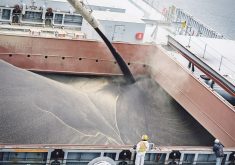The feed wheat contract on ICE Futures Canada may not be dead, but the funeral director is on speed dial.
Open interest in the Winnipeg contract has dwindled to 39 contracts. In comparison, last week open interest in the canola contract was more than 170,000.
Adding to feed wheat’s woes is that all 39 positions are in the May delivery month, with zero open interest in subsequent months. The absence of feed wheat action has led to speculation that ICE Futures will soon put the contract out of its misery.
Read Also

Russian wheat exports start to pick up the pace
Russia has had a slow start for its 2025-26 wheat export program, but the pace is starting to pick up and that is a bearish factor for prices.
“It’s not a functioning contract anymore,” said Jamie Wilton, a broker with MF Global Canada Co. in Winnipeg. Wilton said he hadn’t heard rumours of the contract’s demise, but if it happened, it wouldn’t be a shock.
“If we can’t get the end users and producers to use the contract,” then why have it, he said.
Despite the talk of last rites, the exchange’s official position is that the contract is not finished.
Will Hill, president and chief executive officer of ICE Futures Canada, said there are no immediate plans to take it off the exchange. The exchange will review feed wheat this year, he said, just as it reviews all contracts. There was no date for the review, and for now it’s status quo.
Hill said the feed wheat contract “has always been a challenge,” primarily because its production is distinct from most other crops.
“We grow feed wheat by accident,” said Hill.
Feed wheat, which has been on the Winnipeg exchange since 1974, is a damaged grain, produced when wheat crops are hit by frost or by disease, typically fusarium blight.
It still has value, but it is challenging to discover price if supply is always in question. Also, the contract is not a popular risk management tool, for a simple reason. Why hedge a crop that you don’t plan on growing?
Even with its flaws, grain traders believe the contract is needed.
“I would certainly hope that they don’t (kill it),” said Jack Peters, a broker with Union Securities in Winnipeg.
He added the contract is useful, because without it, there is a vacuum.
“Even if you don’t have a lot of open interest, at least there is some central mechanism,” to establish a benchmark, he said.
“If there is absolutely nothing, it’s just a cash market,” he said, which can vary significantly from one location to the next.
Peters compared the feed wheat contract to the flax one that was delisted in 2005.
“We don’t have a contract (for flax) and there’s no way of knowing, really, what its fair value is,” he said.















